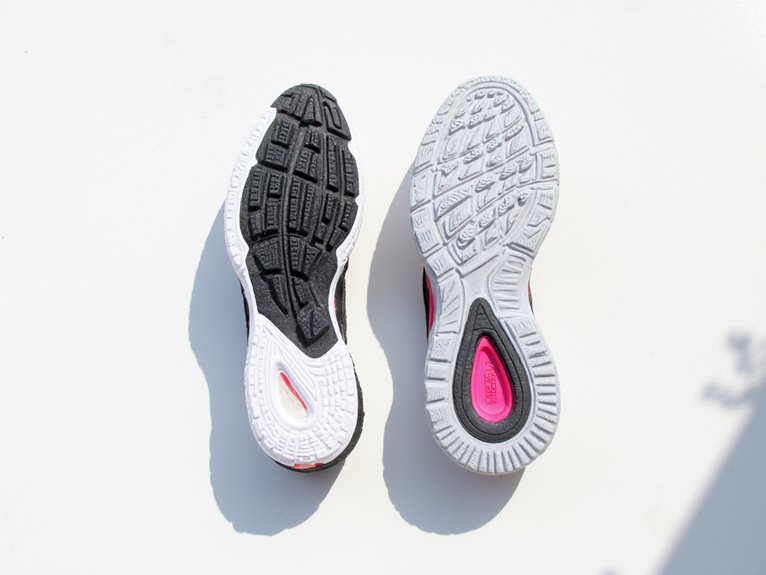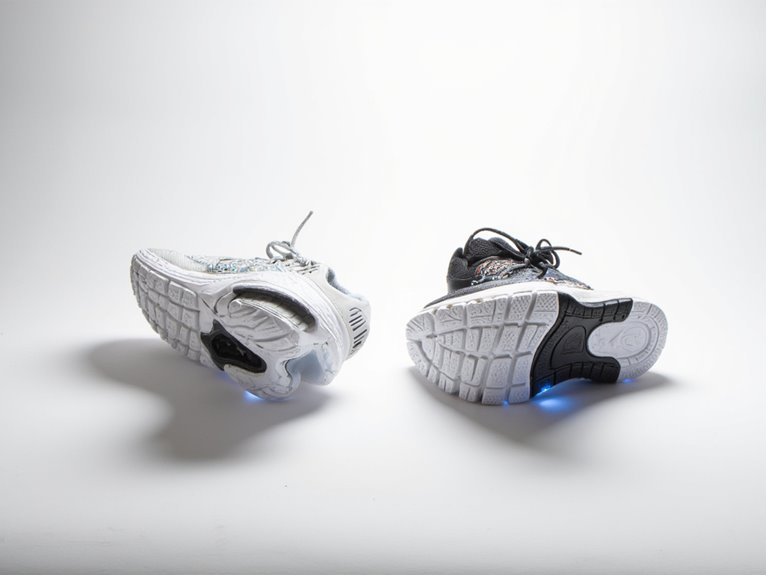Stability vs. Neutral Shoes: How to Choose
Choose stability shoes if you overpronate—your foot rolls excessively inward during landing, creating uneven wear on your shoe’s inner heel and forefoot. You’ll need the medial posts and dual-density midsoles that control this motion. Select neutral shoes if you have normal pronation with a four-degree inward roll and even weight distribution. Neutral models weigh 20-30% less and offer superior shock absorption without corrective elements. Understanding these biomechanical differences reveals the full potential of proper footwear selection.
We are supported by our audience. When you purchase through links on our site, we may earn an affiliate commission, at no extra cost for you. Learn more. Last update on 16th December 2025 / Images from Amazon Product Advertising API.
Notable Insights
- Assess your foot type: flat feet or overpronation typically require stability shoes, while normal arches suit neutral shoes.
- Check current shoe wear patterns: excessive inner heel and forefoot wear indicates need for stability features.
- Consider injury history: runners with past pronation-related injuries often benefit from stability shoe support and alignment correction.
- Evaluate terrain preferences: neutral shoes excel on flat surfaces, while stability shoes provide better control on varied terrain.
- Factor in weight preferences: neutral shoes are 20-30% lighter for energy efficiency during long runs.
Understanding Your Foot Type and Pronation Pattern
Before selecting the right running shoe, you’ll need to understand how your feet naturally move during each step.
Your foot mechanics determine whether you need stability or neutral footwear.
Neutral pronation involves a four-degree inward roll during midstance, distributing weight evenly across your big and second toes.
This pattern typically corresponds with normal arch height and balanced arch flexibility.
Overpronation occurs when your foot rolls inward excessively past midstance.
You’ll likely have flat feet or flexible arches that collapse under load.
Check your shoe wear patterns—excessive wear on the inside heel and forefoot indicates overpronation.
Underpronation means your foot rolls outward too much, stressing the outer edge.
High arches and rigid arch flexibility characterize this pattern.
Your shoes will show wear along the outer heel first.
Overpronation can lead to ankle instability due to uneven shock distribution throughout your gait cycle.
Professional gait analysis can help identify your specific foot motion pattern and guide appropriate shoe selection.
Key Features That Distinguish Stability From Neutral Running Shoes
Once you’ve identified your pronation pattern, the differences between stability and neutral shoes become clear through their distinct construction features.
Stability shoes incorporate medial posts and dual-density midsoles that actively control excessive pronation. You’ll find firmer, more structured materials on the inner side of these shoes. Their shoe construction includes TPU shanks and graduated foam densities for targeted support.
Stability shoes use medial posts and dual-density midsoles with firmer inner materials to actively control excessive pronation.
Neutral shoes emphasize flexibility and natural motion. Their cushioning technology focuses on lightweight EVA foams and softer materials throughout the midsole. You won’t see the corrective elements found in stability models. These shoes aid forward momentum and create smoother transitions from landing to toe-off for more efficient running.
Weight differs noticeably between categories. Stability shoes carry additional supportive materials, making them heavier than their neutral counterparts.
Modern stability designs have evolved from rigid motion-control systems to more adaptable support mechanisms that don’t overly restrict your natural gait patterns. Stability shoes also feature heel counters that provide enhanced foot stabilization and support during your running stride.
Performance Benefits and Injury Prevention for Each Shoe Type
While both neutral and stability shoes serve distinct biomechanical needs, their performance benefits and injury prevention capabilities differ considerably based on your specific gait pattern and foot structure.
Neutral shoes excel in shock absorption and natural foot motion. Their lightweight design enhances running economy while reducing joint stress and overuse injuries. You’ll experience superior cushioning that minimizes impact forces, particularly beneficial for normal to high-arched feet.
The flexible shoe materials promote smooth forward momentum and versatile performance.
Stability shoes provide targeted medial support to correct overpronation. They enhance leg alignment and reduce excessive foot motion through specialized structural elements.
These features actively prevent plantar fasciitis, shin splints, and IT band syndrome. Runner preferences often favor stability shoes for controlling harmful rotational stresses and maintaining proper biomechanical form during intense training sessions.
Methods to Assess Which Shoe Category Fits Your Needs

How do you determine whether stability or neutral shoes align with your biomechanical needs?
Start with a thorough arch height assessment during shoe fitting. Low arches typically require stability shoes with enhanced arch support, while high arches benefit from neutral designs.
Examine your current running shoes’ wear patterns—excessive wear on the inside sole indicates overpronation, necessitating stability footwear.
Professional gait analysis provides the most accurate assessment. Specialty running stores use treadmill testing and video capture to analyze your foot strike pattern and pronation degree.
Professional gait analysis at specialty running stores offers precise biomechanical assessment through treadmill testing and video analysis.
You can perform DIY analysis by observing your wet footprint or monitoring how your foot rolls during movement.
Consider your injury history. Previous shin splints or knee pain from overpronation suggests stability shoes.
Trial runs in both categories help assess comfort and biomechanical support on your preferred terrain.
Additionally, consider incorporating arch support insoles into your shoes if you need extra cushioning and stability beyond what the footwear alone provides.
Weight, Flexibility, and Terrain Considerations for Optimal Selection
Beyond biomechanical compatibility, several physical characteristics of stability and neutral shoes greatly impact your running performance and comfort.
Weight comparison reveals neutral shoes typically weigh 20-30% less than stability models due to fewer structural components. This difference affects energy efficiency, particularly during longer runs where lighter footwear reduces fatigue accumulation.
Flexibility varies considerably between categories. Neutral shoes offer enhanced forefoot flex for natural toe-off, while stability shoes incorporate firmer midsoles that limit excessive motion.
Terrain analysis determines best selection. Neutral shoes excel on flat, predictable surfaces where cushioning and natural movement patterns dominate. Stability shoes perform better on varied terrain, providing essential medial support when uneven surfaces challenge foot alignment and increase overpronation risk.
On a final note
You’ve now got the technical knowledge to select shoes that match your biomechanics. Your pronation pattern determines whether you’ll benefit from stability’s medial posting or neutral’s uniform cushioning. Don’t guess—use the wet foot test or visit a specialty retailer for gait analysis. Consider your weekly mileage, preferred terrain, and injury history when making your final decision. The right shoe category will optimize your performance and reduce injury risk markedly.

